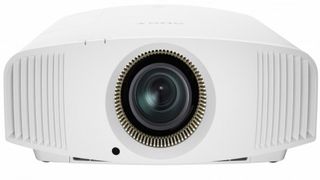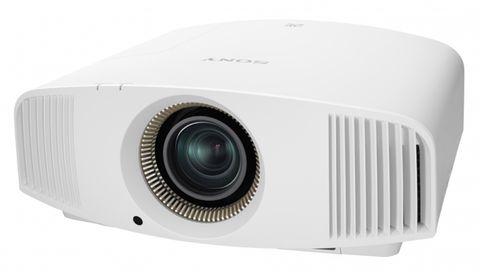Why you can trust TechRadar
For the most part the VW520ES's pictures are nothing short of spectacular.
For starters that native 4K resolution makes itself count in every frame of a good quality 4K source (which at the time of writing means a selection of movie and sports clips stored on a resident hard drive!).
There's more visible detail in heavily textured areas and over well-defined lines than you get with either HD projectors or JVC's 'pseudo 4K' e-Shift projection technology, clearly revealing the benefits of having four times as many true pixels to play with when you're watching the sort of image sizes a projector is capable of delivering.
There's a generally crisper look to 4K content on the VW520ES than you see with JVC's e-Shift technology too, while there's no trace of the jagged edges or visible pixel structure that can appear with HD projectors at large image sizes.
While I was only able to get a few of my collection of HDR clips to play into the VW520ES (because, according to Sony's engineers, the failed clips didn't contain standard HDR image data), I was pleased to see that it delivered a palpable step up in image quality with the next-generation picture technology.

Dynamic
Stand-out colours, in particular, enjoy a potent boost in richness and saturation, and bright elements like stars, sparks and flames stand out from what's around them more dynamically than they do with standard dynamic range sources.
Also playing a part in the VW520ES's often spectacular pictures is its slightly improved contrast performance versus the VW500ES. Blacks look a little deeper and more neutral, while as we've already mentioned, the projector's brightness peaks look more explosive and extreme, especially with HDR content.
Another impressive aspect of the VW520ES's performance is its upscaling of high definition content to its native 4K resolution. Any issues with this upscaling - such as exaggerated source noise, excessive grain and dot crawl or 'ringing' around fine lines - would obviously show up pretty clearly on the sort of screen sizes you can get with a projector like the VW520ES.
The VW520ES's upscaling engine, though, is clever enough to add enough detail to make sure HD sources look at least something like 4K while also suppressing any noise an HD source may contain.
Not so dynamic...
While the VW520ES's pictures always look brilliant and sometimes - with HDR - uniquely mesmerising, there are a handful of issues worth mentioning.
First, the extra brightness range you get with HDR is not as pronounced on the VW520ES as it on some of the brightest HDR TVs I've seen. I guess 1800 Lumens just isn't quite enough - especially in the context of the 1700 Lumens you get from the standard dynamic range VW500ES - to deliver the maximum impact HDR is capable of.
Another point associated with the VW520ES's HDR performance is that you really need to set the lamp to its Normal setting to get the best HDR experience. Which causes a fairly steep increase in the projector's running noise - though to be fair, we're talking an increase from the almost silence of the Eco mode.

The next issue is that the VW520ES does not achieve the same black level depths you get with JVC's D-ILA projection technology. But dark scenes still look natural, engaging and full of detail on the Sony. Plus there's more detail in dark areas with HDR content than you see with SDR material.
The VW520ES is only a fair to middling 3D performer too, thanks to the way some crosstalk ghosting noise fairly often interferes with your enjoyment of the strong contrast, colour and depth performance the projector otherwise delivers with 3D content.
One final point highlighted by recent experience with Texas Instruments' single-chip 4K DLP solution is that the need to align three SXRD chipsets in the VW520ES can occasionally lead to some slight colour distortion - usually a slight infusion of purple - in areas of very fine detail. Though it's important to add that this issue is much easier to see with test signals than it is with 'real world' content.
While it's my job to point out these issues, though, I'd still say there are times, especially with 4K HDR content, when the VW520ES produces the all-round best picture quality I've seen on a sub-£10,000 projector.
Usability and value
The VW520ES is a little quirky in its presentation of some features, but the key points are that its remote control is easy to use, even in a dark room; it's pretty easy to set up and features motorized zoom, focus and image shift; and it has a number of genuinely well-considered and useful picture presets to keep things simple.
Though the number of people not having a £8,800 projector professionally installed and calibrated for them is likely rather limited.
The VW520ES offers a unique feature set and, at times, unique performance level for the sub-£10,000 projector market, making its £8,800 price arguably pretty reasonable. It's worth adding, however, that JVC's X5000 projector offers HDR playback and outstanding contrast for just £4,000 - though its 'e-shift 4K' technology is no replacement for Sony's real 4K deal.
Current page: Picture Performance, Usability and Value
Prev Page Introduction and features Next Page VerdictAV Technology Contributor
John has been writing about home entertainment technology for more than two decades - an especially impressive feat considering he still claims to only be 35 years old (yeah, right). In that time he’s reviewed hundreds if not thousands of TVs, projectors and speakers, and spent frankly far too long sitting by himself in a dark room.

Apple is reportedly developing its own AI servers — could it be gearing up to take on Nvidia and AMD?

This Game Boy-styled MagSafe stand just tickled my retro-gaming synapse – now all I need is a matching controller for Nintendo emulators

AI Explorer could revolutionize Windows 11, but can your PC run it? Here's how to check

